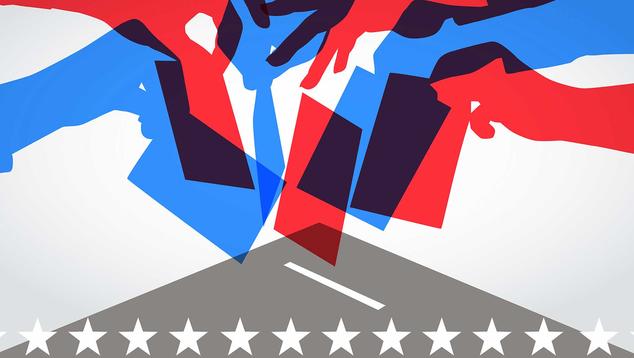WASHINGTON, D.C. -- Republicans and Democrats are highly polarized on a number of prominent U.S. social and policy issues, but there has been significant variation in the trends associated with these partisan gaps over the past two decades. The gaps have increased significantly on some issues but have changed much less on others, even with broad shifts in Americans’ attitudes that affect both partisan groups.
Political polarization since 2003 has increased most significantly on issues related to federal government power, global warming and the environment, education, abortion, foreign trade, immigration, gun laws, the government’s role in providing healthcare, and income tax fairness. Increased polarization has been less evident on certain moral issues and satisfaction with the state of race relations.
Trends at Three Points in Time
The current analysis examines attitudes measured in Gallup polls conducted at roughly 10-year intervals between 2003 and 2023. A prior Gallup analysis, looking at the trend in partisans’ stances on a smaller number of U.S. issues between 2000 and 2017, found many of the same patterns.
In all, 24 issues are included in this review. As was the case in 2017, these do not represent the universe of all possible topics but are those that have particular societal importance based on visibility, political prominence and news coverage. The baseline year for each trend is Gallup's measurement 20 years ago, typically 2003, followed by the measurement 10 years ago, typically 2013, and then the most recent measure from either 2022 or 2023.
The partisan analysis is based on a comparison of Democratic identifiers and Democratic-leaning independents versus Republican identifiers and leaners. The results using this measure of “leaned party” differ slightly from the results that are obtained when looking at Democrats and Republicans without leaning independents included, but the overall patterns are the same using both approaches.
The Partisan Gaps Over Time
Over the past two decades, partisan gaps on all of the issues included in this analysis have either remained roughly the same or expanded. This reinforces the fundamental (albeit not surprising) conclusion that when Americans are divided into two groups based on their political identity, they are also predictably divided into two groups on a wide range of politically and socially important issues.
From the broadest perspective, the issues and topics on which the partisan gaps have grown the most since 2003 are (predictably) the issues that have been at the forefront of the political and ideological battleground in recent years and that have gained high visibility in the media. These include views of government power, global warming and the environment, education, abortion, foreign trade, immigration, gun laws, healthcare, and income tax.
Attitudes on other issues have undergone less change over time -- in some instances, resulting in partisan gaps that have stayed roughly the same since 2003. These include views on the moral acceptability of various issues such as sex before marriage and having a baby outside of wedlock and satisfaction with the state of race relations.
The charts below present these changes in partisan gaps over time in more specific detail, including the responses of the two partisan groups at each of the three points in time used in this analysis.

Custom graphic. 24 line charts showing the differences between Republicans and Democrats views on 24 issues that affect Americans' voting patterns.
Issues on Which There Has Been Significant Change Over the Past Two Decades
- There was virtually no gap between Democrats and Republicans in 2003 on perceptions that the government has too much power. This reflected, at least in part, the continuing aftermath of the 9/11 terrorist attacks, a time marked by unusual public consensus on the role of government in addressing major problems like terrorism. By 2013, however, during the Democratic presidency of Barack Obama, Republicans had become much more likely than Democrats to believe the federal government has too much power, creating a large partisan gap in 2013 that has continued this year.
- Democrats have steadily become more concerned about global warming and convinced that human activity is the main cause of global warming over the past two decades. Republicans’ worry about global warming, in contrast, edged down slightly in both 2013 and 2023, creating larger partisan gaps in each of those two years. Similarly, Republicans’ views that global warming is the result of human activity dropped between 2003 and 2013, expanding the difference with Democrats’ views, and this gap has expanded even more this year. A significant 2003 gap in views that protecting the environment should be prioritized over the development of energy sources grew in 2013 and has widened further this year, as Democrats have become increasingly likely to agree with the environmental prioritization position. Republicans’ views, as was the case for their views on humans’ role in global warming, have stayed roughly constant over the past decade.
- In 2003, Republicans were slightly more satisfied than Democrats with K-12 education. That Republican edge has now flipped to a Democratic advantage, reflecting a drop in Republicans’ satisfaction with education.
- Democrats’ views that abortion should be legal under any circumstance increased significantly this year compared with 10 and 20 years earlier, while Republicans’ much lower agreement with legal abortion has remained relatively constant. The change in Democratic views on abortion likely reflects their reaction to the June 2022 Dobbs decision that overturned Roe v. Wade. The result: The partisan gap on abortion evident in 2003 and 2013 has expanded this year to be one of the largest gaps measured.
- There was little disagreement between Democrats and Republicans in either 2003 or 2013 in terms of views that foreign trade represents economic opportunity. But in recent years, Democrats’ agreement with that sentiment has increased significantly. That change -- coupled with Republicans having similar views in 2013 and 2023 -- has resulted in a substantial partisan gap in views of foreign trade.
- Two questions on immigration included in this analysis show different trend patterns. Republicans’ views that immigration is good for the country have dropped significantly, while Democrats’ views have remained roughly stable, resulting in an increased partisan gap. Both groups have moved in opposite directions on the question of decreasing immigration, with Republicans becoming more likely and Democrats less likely to say that immigration should be decreased. The net result is a significantly increased partisan gap in 2023 compared with 10 and 20 years earlier.
- Democrats are much more likely than Republicans to say the country needs stricter gun laws, as was the case in 2003 and 2013. Both Democrats’ and Republicans’ views that there should be stricter laws have edged up since 2013, maintaining but not expanding the substantial partisan gap.
- Democratic and Republican views that the government should ensure everyone has healthcare have been predictably divergent in each of the three years included in this analysis. Republicans became particularly less supportive in 2013, with a modest pullback from that view since. But this change, combined with an increase in the already high Democratic sentiment, puts this issue as one of the two with the largest partisan gaps of any of the measures included in the analysis.
- There was almost no partisan gap in perceptions of the fairness of the amount of income tax that individuals paid in 2003 (perhaps reflecting the 9/11 aftermath), but the gap has expanded in the decades since. Republicans have become substantially less likely to say that the income tax they pay is fair, while Democrats’ more positive views have remained generally steady.
Issues on Which There Has Been Less Substantial Change Over the Past Two Decades
- Since 2003, Democrats have been more likely than Republicans to say that marijuana should be legalized. The percentage of each partisan group agreeing with legalizing marijuana increased in lockstep in 2013 and then again in 2022, but the Democratic increase has been modestly larger than Republicans’, resulting in a somewhat bigger partisan gap on this issue when measured last year than 20 years ago.
- Democrats’ support for legalizing same-sex marriage has steadily increased over the past two decades. Republicans are much less likely to share this sentiment in general, but their support for legalized same-sex marriage nevertheless has increased significantly since 2013. The result has been a fairly constant partisan gap on the issue over the decades, even as both groups have become more supportive.
- Democrats are more accepting than Republicans on each of three moral and values issues included in this analysis -- having a baby outside of marriage, sex between unmarried partners, and divorce. Both groups have been increasingly likely to say these issues are morally acceptable, resulting in fairly constant partisan gaps in 2003, 2013 and 2023.
- Both partisan groups held similar views about doctor-assisted suicide in 2003 and 2013, but Democrats this year have become somewhat more likely to view the practice as acceptable, while Republicans have become somewhat less so. This has created a significant partisan gap compared with the 2003 measurement.
- Republicans had slightly more confidence in the police than Democrats in 2003, but Republicans’ confidence level edged down in 2013, resulting in almost no partisan gap that year between their views and the views of Democrats. Democrats’ confidence in the police has plunged in the past decade among heightened sensitivity to racial injustice in policing, while Republicans’ confidence has edged down only slightly, once again creating a significant gap when measured last year.
- Democrats, not surprisingly, have been significantly more likely than Republicans to say the government should do more to solve the nation’s problems in 2003, 2013 and again last year -- without a lot of major change in the resulting partisan gap across the past two decades.
- The partisan gap in support for the death penalty in cases of murder has been consistent throughout the past two decades, with Republicans much more likely to be in favor. However, both groups' support is modestly lower now than in 2013.
- Republicans are more likely than Democrats to say they sympathize with the Israelis rather than the Palestinians in the Middle East situation, as was the case in 2003 and 2013. But Democrats’ sympathy with the Israelis has dropped significantly compared with the previous measures (particularly 2013), resulting in a somewhat increased partisan gap.
- Both partisan groups have become less satisfied with the state of race relations in the U.S. since 2013, when there was virtually no difference between the two groups. The Democratic decline in satisfaction is larger than it is among Republicans, meaning that the partisan gap evident in 2003 has returned, albeit somewhat larger this year than in 2003.
- Both partisan groups’ favorable opinions of Cuba have edged up since 2003, with Democrats consistently holding a somewhat more positive view than Republicans. The size of the gap has remained roughly the same over time.
Public opinion on each of the issues included in this analysis is formed, sustained and changed as the result of a large number of factors, many of which are idiosyncratic to the history and nature of the particular issue involved.
One of these factors is the impact of the party of the president in the White House. Generally speaking, Americans are more positive about issues and situations when their party controls the presidency than when it does not. Democrats occupied the White House in 2013 and do so this year, so the party in the White House presumably isn’t a factor in 2013 vs. 2023 comparisons. A Republican occupied the White House in 2003, however -- which could be a factor affecting the comparison of Americans’ issue positions in that year to 2013 and 2023, particularly on questions that evaluate the state of the nation, such as attitudes toward government power and satisfaction with education.
There Are Partisan Gaps on All Issues, Although Variable in Size
The 24 issues and topics included in this analysis were selected because of their prominence in political discussions and controversies, so it comes as no shock to find universal, although variable, differences in how Republicans and Democrats view each of them as outlined in this analysis.
These gaps have shifted over time, as noted, ending in a situation wherein the largest gaps in the latest available data appear in views on the government’s role in providing healthcare, global warming and environmental issues, gun laws, abortion, and the role of the federal government. None of these are surprising to students of contemporary politics, and more detailed discussions of why these issues have developed such significant political fissures in the U.S. today are provided in the Gallup analyses linked in the paragraphs above.
Bottom Line
Political polarization remains an enormously important part of the U.S. political landscape. There are significant -- and in some instances, huge -- partisan differences today in views on all 24 issues included in this analysis. This confirms the fundamental foundation for any analysis of U.S. politics -- the fact that individuals’ political identity is highly correlated with their views of social and policy issues, resulting in substantial differences in how issues are viewed across political segments. This in turn reflects the fact that the two major political parties have staked out widely differing positions on the types of issues included in this analysis.
Americans’ political identity arises from a number of sources, and it’s possible that Americans’ position on issues helps them settle in on their partisanship. And, once a person has established their partisan leanings, the party’s platform (often amplified by partisan media consumption) can in turn be a factor in reinforcing the individual’s position on social and political issues.
The consequences of the type of issue polarization reviewed in this analysis are widespread. The division in issues positions between parties, for one thing, can mean there is little variation within parties, which in turn can mean that choice of candidates in primaries can depend on how strongly the candidates profess allegiance to the party’s positions and on non-issues factors such as personality, character and history.
Gallup’s analysis six years ago concluded that “Republicans and Democrats over the years have increasingly diverged in their opinions on a number of important policy and social issues.” That statement remains true today for some issues, based on a more detailed analysis of long-term trends, but the current analysis reveals that steady increases in the partisan gaps are by no means universal across all issues.
To stay up to date with the latest Gallup News insights and updates, follow us on Twitter.




